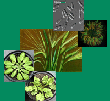| Kühnlenz, T; Schmidt, H; Uraguchi, S; Clemens, S: Arabidopsis thaliana phytochelatin synthase 2 is constitutively active in vivo and can rescue the growth defect of the AtPCS1-deficient cad1-3 mutant on Cd-contaminated soil., J. Experimental Botany (2014), doi:10.1093/jxb/eru195 [Link] | |
| Abstract: Phytochelatins play a key role in the detoxification of metals in plants and many other eukaryotes. Their formation is catalyzed by phytochelatin synthases (PCS) in the presence of metal excess. It appears to be common among higher plants to possess two PCS genes even though in Arabidopsis thaliana only AtPCS1 has been demonstrated to confer metal tolerance. Employing a highly sensitive quantification method based on ultra performance electrospray ionization quadrupole time-of-flight mass spectrometry (UPLC-ESI-QTOF-MS) we detected AtPCS2-dependent phytochelatin formation. Overexpression of AtPCS2 resulted in constitutive phytochelatin accumulation, i.e. in the absence of metal excess, both in planta and in a heterologous system. This indicates distinct enzymatic differences between AtPCS1 and AtPCS2. Furthermore, AtPCS2 was able to partially rescue the Cd hypersensitivity of the AtPCS1-deficient cad1-3 mutant in a liquid seedling assay and, more importantly, when plants were grown on soil spiked with Cd to a level that is close to what can be found in agricultural soils. No rescue was found in vertical plate assays, the most commonly used method to assess metal tolerance. Constitutive AtPCS2-dependent phytochelatin synthesis suggests a physiological role of AtPCS2 other than metal detoxification Differences observed between wild-type plants and cad1-3 on Cd soil demonstrated (i) essentiality of phytochelatin synthesis for tolerating levels of Cd contamination that can naturally be encountered by plants outside of metal-rich habitats, and (ii) a contribution to Cd accumulation under these conditions. |

